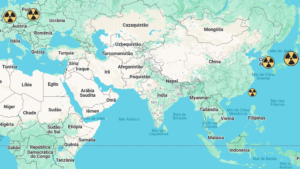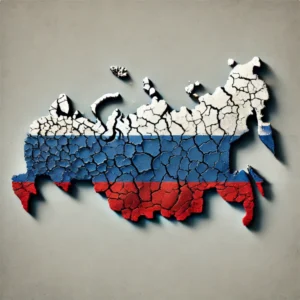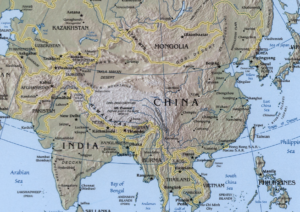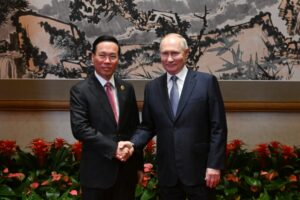- Ukrainian reports claim that Russian armored vehicles and helicopters are incapable of withstanding small-arms fire;
- As a result of the war and economic sanctions, the russian government was forced to terminate arms contracts with importing countries;
- Some countries that depend on Russia for their defense needs may look to other arms suppliers or become more self-sufficient.
The countries that manufacture the most arms in the world, according to a report by the Stockholm International Peace Research Institute (SIPRI), are the United States, Russia, France, Germany, and China.
Together, these five countries are responsible for the export of approximately 75 percent of the world’s weapons. The United States leads the export ranking and Russia is right behind, being the second largest arms exporting country in the world.
However, in the War in Ukraine during 2022, the extensive use of weaponry by the Russian army and the international sanctions employed against Russia are hurting Moscow’s war industry.
Added to this is the poor performance of Russian weapons used in Ukraine. These two elements make it possible for traditional importers of Russian arms to direct their imports to other potential arms suppliers, such as the other four large producers mentioned above, for example.

Which countries import the most weapons and warfare systems from Russia, and what are these weapons?
According to the Russia Beyonds platform, the countries and regions that have bought the most Russian weapons in recent years are India, countries in Africa and the Middle East, countries of the Former Soviet Union, Latin American countries, and, surprisingly, the United States.
India, Russia’s largest customer, signed a $590 million contract with the Kalashnikov Consortium in 2021. In addition, the country also had an agreement signed in 2018 that provides for the shipment of Russian S-400 anti-aircraft defense systems.
Also in the year 2021, Russia held a military exhibition to 17 African countries and also held military exhibitions in the Middle East. The military agreements signed total $1.7 billion and $1.3 billion, respectively.
The Russian company responsible for exports, Rosoboronexport, did not make clear which countries are buyers, but said that among the exports would be helicopters, air defense systems, naval equipment, light armored vehicles, and firearms.
While not disclosing the value of military contracts, Rosoboronexport specified that Russia was the largest arms exporter in the Commonwealth of Independent Countries (CIS). Among the 11 republics that were part of the Former Soviet Union, Kazakhstan and Belarus were the main arms importers until then.
According to Russian media reports, Kazakhstan has reportedly received five divisions of S-300PS air defense systems, 16 Su-30 generation 4+ multifunctional fighters, and has extended contracts to import Su-30SM fighters. Belarus, meanwhile, has reportedly received S-300 air defense systems and Yak-130 training aircraft.
In Latin America, the Russians maintain military contracts with Argentina, Brazil, Colombia, Ecuador, Peru, Uruguay, and the main customer, Venezuela. The Venezuelans have received BMP-3M infantry fighting vehicles, BTR-80A armored personnel carriers, Msta-S artillery systems and Grad multiple rocket launcher systems.
In addition, it has signed contracts for the import of T-72B1 tanks, S-300VM air defense systems, Buk-M2 and Tor-M1. Finally, its Air Forces have also received Russian battle and transport helicopters, such as the Mi-17-1B ‘Panare’, Mi-26T2 ‘Pemon’ and Mi-35M2 ‘Caribe’, as well as numerous Su-30MK2B multi-role fighters.
In the case of the United States, its companies imported Russian small arms ammunition totaling $157.9 million in 2021 for AK assault rifles in the civilian market. However, these companies will need to look for new suppliers due to the sanctions put in place because of the war in Ukraine.
Main Russian weapons imported, according to SIPRI
- India
In 2012, the country purchased 42 Sukhoi Su-30s, a military fighter known for its great maneuverability. A few years later, in 2017, India purchased two airborne control alert systems, the A-50ehl, in addition to MiG-29SMTs fighter, used for air combat.
The nation’s latest purchase was 1,000 T-90 tanks, of which 220 have already been delivered. Five S-400 missile defense systems have been selected, but the purchase has not yet been closed.
- Egypt
The country that connects northeastern Africa with the Middle East has already made its Russian imports. In 2015, 46 Ka-52 combat helicopters were purchased, in addition to 50 MiG-29M military aircraft.
Egypt also purchased several different types of surface-to-air missiles in 2014 and 2015. Most of these purchases were delivered only in 2017.
- China
In China, 24 Su-35 military aircraft were purchased in 2015, delivered in 2016 and 2017. Also in 2015, the country with the world’s largest population purchased six S-400 anti-aircraft defense missiles.
- Algeria
Located in North Africa, Algeria is a former operator of Russian weapons. In the year 2013, some 42 Mi-28N combat helicopters were purchased. A few years later, in 2014, the country purchased two Kilo-class Type 636 submarines.
In addition, in 2015 Algeria ordered eight Mi-26 transport helicopters, which were all delivered in 2017.
- Vietnam
In 2009, Vietnam purchased six Kilo-class submarines, the Type 636, which were just delivered in 2017. In the very same year, 64 Russian T-90S tanks were purchased.
- Angola
Angola’s investment in Russian weapons was $188 million, with the country purchasing 12 Su-30K military aircraft, half of which were delivered in 2017.
- Kazakhstan
In the year 2017, Kazakhstan purchased four Mi-35M combat helicopters and 12 Su-30MK military aircraft, of which two were delivered in the same year.
A few years earlier, in 2012, the country purchased 90 BTR-82A infantry fighting vehicles, which were delivered in 2017.
- Belarus
In 2015, the country purchased 12 Mi-8MT/Mi17 transport helicopters, delivered between 2016 and 2017. Also in 2017, Belarus purchased 12 Su-30MK military aircraft and one hundred SA-15 Gauntlet missiles, and also received four T-72B3 tanks.
- Azerbaijan
Azerbaijan purchased 36 TOS-1 multiple rocket launchers in the year 2011, which had their deliveries between 2013 and 2017. A year before its last launcher was delivered, in 2016, the country purchased 70 BTR-82A infantry fighting vehicles and 40 of them were delivered the very next year.
- Bangladesch
As the country on the list that has invested the least in Russian military weaponry, Bangladesch purchased six Mi-8MT/Mi-17 transport helicopters in 2015, which were delivered only in 2017, the same year the country purchased five more of the same.
In 2014, Bangladesch purchased 340 troop transport vehicles, all of which were delivered between 2016 and 2017.
Why is the inefficiency of Russian weaponry in the Ukraine theater of operations leading some importing countries to withdraw its use?
Despite superior firepower, Russian forces have failed to regain the advantage over Ukraine. A Ukrainian Defense Ministry report seen by The Times, concluded that Russian weapons are old and ineffective, failing to meet modern requirements.
The report claims that Russian armored vehicles and helicopters are unable to withstand small arms fire, while rockets were only 33% likely to hit targets.
One of Russia’s most modern attack helicopters – the Ka-52 Alligator – could have its armor penetrated by a 7.62mm caliber firearm, when it was built to withstand the impact of 12.7mm caliber bullets.
The document says that despite Russia’s claims that it had improved armor protection, the Ural-63706-0010 Tornado-U heavy utility truck has “weak protection against small arms damage.
Furthermore, the BMD-4M – an amphibious infantry fighting vehicle – was “weakly protected even against small arms and mine fragments and artillery shells.”
Finally, the war in Ukraine has reinforced the well-known design problem of major Russian fighting cars (“tanks”) such as the T-62 and T-72 that tend to suffer catastrophic destruction when they receive enemy impact near their internal automatic loader.
All these performance problems of Russian weaponry when tested on the actual battlefield have led traditional importers to be concerned about their heavy reliance on these Russian systems and to start looking for alternative weapon suppliers.
What are the main weapon systems on the market that can replace low quality Russian weaponry?
Due to the problems presented in Russian armaments, we present a list of possible non-Russian weapon systems that could benefit from this supplier swap:
Fighters
- F18, USA. It is a twin-engine, supersonic, all-weather multifunction jet and can also be used on aircraft carriers. Some countries that operate them are Canada, Finland, Australia, among others.
- F35, USA. It is a fifth generation stealth supersonic multifunction fighter that is being produced and used by dozens of countries aligned with the United States;
- Rafale, France. It is a twin-prop fighter with a delta wing, considered fourth and a half generation, designed in the 1980s. India is already a Rafale operator and so would be a natural major importer;
- Eurofighter, Europe. It is a fighter and fighter-bomber aircraft with the ability to reach supersonic speed for long periods. Used by several European Union countries, in addition to the United Kingdom;
- Gripen, Sweden. Also designated as the F-39 Gripen, being a fourth and a half generation single-engine light multipurpose fighter, already exported to Brazil, Thailand, Hungary, among others.
Fighting Cars or “Tanks”
- M1 Abrams, USA. is a third generation American main battle tank, and one of the heaviest tanks in service. The main countries using this tank, besides the United States itself, are Egypt and Saudi Arabia;
- Leopard 2, Germany. This tank is the answer to the appearance of the Russian T-64 and T-72 tanks, with 125mm cannons. The largest operators of this tank are in the European Union, such as Spain, Portugal, and Greece, as well as Turkey and others;
- Leclerc, France. The first Leclerc entered service in 1992, to replace the AMX-30s as the country’s main armored platform. Besides France itself, another operator of the Leclerc is the United Arab Emirates and Colombia is a possible operator;
- Arjun, India. Developed for the country’s own use, the Arjun seems to take advantage of the capacity created in India to produce tanks of the T-72 family, (T-72 M1). Since it was developed for the country, it is still it’s only operator, but possible operators include Bahrain and Colombia;
- Challenger 2, UK. The manufacturer announced the armored truck as the most reliable in the world. Outperforming according to the company is its continental rivals: the German Leopard 2 version A6, the French AMX-56 Leclerc, the Italian Ariete and even the US M1A1 Abrams. The main users are the UK and Oman;
- Merkava, Israel. It is a series of main battle tanks used by the Israel Defense Forces and the backbone of the armored corps. It would be a possibility, however its export has not been successful;
- K2, South Korea. The K2 Black Panther is a combat car that is derived in terms of outline from the earlier K1 and K1A1. The tank is used in Turkey, in addition to South Korea itself and in the future, Poland.
Attack Helicopters
- Apache, USA. It is the main helicopter of the USA, successor of the AH-1 Cobra. It is currently considered the best attack helicopter in the world, being used in various hostile environments and with high success rates in its missions. Its main operators are Japan, Egypt, Greece, India, South Korea, Taiwan and others;
- Tiger, France. Development of the Tiger began during the Cold War, and it was initially designed as an anti-tank helicopter to be used against the Soviet Union during the ground invasion of Western Europe. Countries that use this equipment besides France are Australia, Germany, and Spain;
- Bell AH-1, USA. It is an attack helicopter manufactured by the American company Bell Helicopters as a successor to the AH-1 Cobra model and has become the backbone of the United States Marine Corps attack helicopter fleet. South Korea, Japan, Israel, Pakistan and Thailand are also some of the many countries using this aircraft;
- WZ-10, China. It is primarily designed for anti-tank warfare missions, but also has secondary air-to-air combat capability. Currently, this helicopter operates only in the Chinese republic;
- Harbin Z-19, China. It is a Chinese light reconnaissance/attack helicopter developed by the Harbin Aircraft Manufacturing Corporation (HAMC). Like its predecessor, this equipment only operates in Chinese territory;
- Mangusta, Italy. It is an attack helicopter originally developed by the Agusta company. It became one of the first advanced helicopters to be produced in Europe;
Multiple rocket launchers (Artillery)
- Multiple rocket launchers, USA (M142 HIMARS). This is a United States multiple rocket launcher system mounted on a standard military truck. This system may be strongly considered after its success in Ukraine, and also has an operational history in Afghanistan and the Middle East;
- Astros 2020 (Mk6), Brazil. It is capable of launching ammunition of different calibers at distances between 9 and 300 km. It is employed to shoot down targets of great importance and strategic targets. It can be employed in ground and littoral defense, particularly in operations against amphibious landing. Its operators are in Angola, Saudi Arabia, Bahrain, Qatar, Libya and others;
Air-to-air missile defense system
- Terminal High Altitude Area Defense (THAAD), EUA. It is designed to shoot down short, medium and intermediate range ballistic missiles. This missile system has also been deployed in the United Arab Emirates, South Korea, and Turkey;
- Iron Dome, Israel. It is a mobile air defense system for all climates. It will be a good option even though the country has refused to sell its system to Ukraine, due to its strong ties with Russia. In addition, some countries such as Romania, India, Azerbaijan, and the United States have access to the equipment;
- NASAMS air defense system, USA. It is a distributed, networked, short- to medium-range ground air defense system. Several countries are operators of this system, such as Australia, Chile, Finland, Indonesia, Lithuania, Spain, the United States, and others;
- MIM-104 Patriot, USA. It is a surface-to-air missile (SAM) system, the main one of its kind used by the United States Army and several allied states. Some of the user countries are Spain, Germany, Greece, Taiwan, Japan and others;
- IRIS-T, Germany. It is one of the most advanced in the world and is designed to provide medium range and high altitude coverage. Its operators are Brazil, Egypt, Italy, Greece, Spain, South Africa, and others;
It is important to note that although these systems are more modern and efficient than Russian weaponry, one must take into consideration their availability for export and the producers’ interest in transferring technology.
Russia has a history of selling weapons “to whoever can afford them. Some other countries, like the United States for example, usually take into consideration the political ties with their potential buyers.
Why does the loss of the international military market for Russian armaments matter?
The longer the Russian war in Ukraine persists, the more challenging the situation will be for Russia’s war industry, which is being targeted by unprecedented Western sanctions.
While their full impact may not be evident now, these tensions are likely to have long-term implications for Russia’s ability to project its influence abroad through arms sales.
As the U.S. and its allies invest in the defense of Ukraine, Russia suffers from losses of weapons and fighters. This causes countries around the world to be rethinking defense budgets, materiel needs, and military relationships.
Countries that have historically had reduced defense spending, such as Japan and Germany, are increasing it, while nations that buy most of their weapons from Russia are questioning its reliability and future delivery.
India, for example, in 2022 started a search for military equipment and ammunition in domestic companies and Eastern European countries. This search for new suppliers has become essential due to this time when Moscow is fighting a war with Ukraine and facing sanctions.
The most obvious potential competitor to Russia is China. China is not exactly a new player in the global arms market, but its growing technological capabilities imply that it is preparing to move beyond its traditional role as a provider of low-cost, low-capability weapons to possibly claim the niche Russia currently occupies for large, more complex weapons systems.
China is not capable of unseating the weapons of the United States or Europe, which are considered to be of a high standard or quality and state-of-the-art. But it is possible that China could fill the market niche that Russian arms manufacturers have dominated, gaining the political and economic benefits that come with this new configuration.
Another possibility is that some countries that have depended on others for their defense needs may seek to become more self-sufficient in domestic arms production.
Brazil, Turkey, and other emerging market countries have also developed their own defense industries over the past two decades to reduce their dependence on arms imports. Therefore, the Ukraine war could accelerate this process.
Putin probably didn’t expect to shake up the global arms market with his effort to annex Ukraine – or cause his country’s arms sector to decline. But this is just one more way in which his war is massively changing the course of geopolitics in ways that are increasingly unfavorable to Russia’s future as a power of international influence.











[…] the other hand, Russia and China still want to take the hegemony and concentration of power out of the hands of the […]